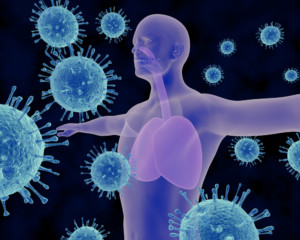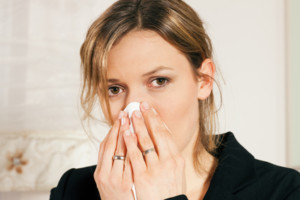Colds & Flu & Sore Throats
 Cold, flu, and Sore throat are infections that are respiratory and interrupt your work and lifestyle.
Cold, flu, and Sore throat are infections that are respiratory and interrupt your work and lifestyle.
Cold viruses attack the upper respiratory tract. The flu (used to be called the grippe) is a viral infection that comes on suddenly, usually bringing fever, sore throat, runny nose, cough, and general weakness. Your muscles and headache. You may get chills. Most colds clear up on their own in a week or ten days, but occasionally a cold can lead to a more serious illness, such as bronchitis, pneumonia, or the flu.
Flu viruses and cold viruses are completely different.
The Cold

Sneezing, scratchy throat, runny nose-everyone knows the first signs of a cold, probably the most common illness known.
The Causes
The Viruses. More than 200 different viruses are known to cause the symptoms of the common cold. Some seldom produce serious illnesses. Others produce mild infections in adults but can precipitate severe lower respiratory infections in young children. Since there are so many different viruses, there has never been a shot for the cold.
The Cold Season
In the United States, most colds occur during the fall and winter. Beginning in late August or early September, the incidence of colds increases slowly for a few weeks and remains high until March or April, when it declines. The seasonal variation may relate to the opening of schools and to cold weather, which prompts people to spend more time indoors and increases the chances that viruses will spread from person to person.
Seasonal changes in relative humidity also may affect the prevalence of colds. The most common cold-causing viruses survive better in the colder months of the year. Cold weather also may make the nasal passages’ lining drier and more vulnerable to viral infection.
Cold Symptoms
Symptoms of the common cold usually begin two to three days after infection and often include nasal discharge, obstruction of nasal breathing, swelling of the sinus membranes, sneezing, sore throat, cough, and headache. Fever is usually slight but can climb to 102 degrees F in infants and young children. Cold symptoms can last from two to 14 days, but two-thirds of people recover in a week. If symptoms occur often or last much longer than two weeks, they may be the result of an allergy rather than a cold.
Colds occasionally can lead to secondary bacterial infections of the middle ear or sinuses, requiring treatment with antibiotics. High fever, significantly swollen glands, severe facial pain in the sinuses, and a cough that produces mucus may indicate a complication or more serious illness requiring a health practitioner’s attention.
How Cold Viruses Cause Other Body Conditions
Viruses cause infection by overcoming the body’s complex defense system. The body’s first line of defense is mucus, produced by the membranes in the nose and throat. Mucus traps the material we inhale: pollen, dust, bacteria, and viruses. When a virus penetrates the mucus and enters a cell, it commandeers the protein-making machinery to manufacture new viruses, which, in turn, attack surrounding cells.
Cold symptoms: the body fights back. Cold symptoms are probably the result of the body’s immune response to the viral invasion. Virus-infected cells in the nose send out signals that recruit specialized white blood cells to the site of the infection. In turn, these cells emit a range of immune system chemicals. These chemicals probably lead to the symptoms of the common cold by causing swelling and inflammation of the nasal membranes, leakage of proteins and fluid from capillaries and lymph vessels, and the increased production of mucus.
How Colds are Spread
Depending on the virus type, any or all of the following routes of transmission may be common:
Touching infectious respiratory secretions on skin and on environmental surfaces and then touching the eyes or nose. Inhaling relatively large particles of respiratory secretions is transported briefly in the air. Inhaling droplet nuclei: smaller infectious particles suspended in the air for long periods of time.
Research on transmission. Much of the research on the transmission of the common cold has been done with rhinoviruses (viruses of the nose), which are shed in the highest concentration in nasal secretions. Studies suggest a person is most likely to transmit these viruses in the second to fourth day of infection, when the amount of virus in nasal secretions is highest. Researchers also have shown that using aspirin to treat colds increases the amount of virus shed in nasal secretions, possibly making the cold sufferer more of a hazard to others.
For Sore Throats Seagate Olive Leaf Throat Spray Unflavored, 1-Ounce Boxes (Pack of 2)
What Causes Coughing with Mucus and Phlegm? What does it mean?
A cough that is accompanied by mucus or phlegm (sputum), commonly called a “productive cough,” is usually a sign that an infection has developed in the lungs.
This can be caused by various things such as the common cold, allergies, irritants (smoking, dust, pet dander, chemical fumes), gastro-esophageal reflux or bacterial or viral infections in the lungs, such as acute bronchitis, pneumonia, whooping cough, croup in children.
The mucus or phlegm often varies in consistency and can be yellow, green, brown, grey, or may even contain blood.
Some common causes include:
- Common cold
- Irritants (e.g., smoking, dust, pet dander, chemical fumes, etc.)
- Allergies (hayfever)
- Gastroesophageal reflux
- Bacterial or viral infections in the lungs
- The flu
- Acute bronchitis
- Pneumonia
- Whooping cough
- Croup in children
- Tuberculosis (TB)
- Lung cancer
- Acid reflux
- Mono
- Chemotherapy
What Foods increase this production of mucus and phlegm?
- Dairy and milk products, such as cheese, yogurt, and cottage cheese
- Refined sugars, such as those in white flour and bread, also lessen immunity.
- Chocolate
- Soy
- Salty foods
- Yeast products
Reasons for Colored Mucus and Phlegm
Yellow – may be a sign of a lower respiratory tract infection or a bacterial infection, sinus infection, cold or flu, allergy, or bronchitis.
Green – may be a sign of pneumonia.
Brown – may be from inhaling dust or smog, or a sign of infection or blood.
Grey – may be a sign of inhaling air pollution.
Red / Pink – may be a sign of blood.
RECOMMENDED
Building Immune System Health
Fight the possibilities of colds, flu & sore throats by building you immune system’s health.
The Flu

We’ve all been hearing a lot about the flu lately, and there is controversy around flu shots and worry about another pandemic.
The flu is a respiratory infection.
Any flu should be prevented and treated by addressing the immune system. There are different supplements you can take on a regular basis to boost the immune system.
RECOMMENDED:
Fight the possibilities of colds, flu & sore throats by building your immune system’s health. We recommend understanding the immune system and working out how to improve its function. See Immune Health
Prevention
Individuals with the flu (or a cold) should always sneeze or cough into a facial tissue and promptly throw it away. If possible, one should avoid close, prolonged exposure to persons who have the flu.
Because rhinoviruses (viruses of the nose) can survive up to three hours outside the nasal passages on inanimate objects and skin, cleaning environmental surfaces with a virus-killing disinfectant might help prevent the spread of infection.
Treatment if you have the Flu.
Vitamin C – One of the most important things that is needed is Vitamin C. The body will need 5,000-20,000 mg per day to fight the infection. But you want a real whole food, natural vitamin C, not something made in the lab and given the name “ascorbic acid”. Ascorbic Acid is just part of the C complex and wanting C and getting ascorbic acid is like wanting an egg and getting the shell.
A natural vitamin is a food that the body recognizes as food, can assimilate, and use to fight the virus infection.
Click on the Vitamin C link for an exceptionally good form of Vitamin C. It doesn’t upset your stomach and really makes a difference. Go to Vitamin C
Calcium Magnesium – An important nutrient in fighting infection. The body needs calcium when fighting infection. If you are not getting enough Calcium in you food, the body will start using calcium from the body – this is the main reason for body aches, the calcium in the muscle is being used.
Here again, a whole food calcium-magnesium is needed. You can also get a Vitamin Mineral and Calcium Magnesium that will help you to build up that body and is a good thing to take to ward off any flu.
See the Whole Food Calcium, Magnesium, and other whole food nutrients
Note: if you wish to just order these vitamins – call 818 252-1038
For Sore Throats: Seagate Olive Leaf Throat Spray Unflavored, 1-Ounce Boxes (Pack of 2)
Other things that help
Hot tea with a little honey is a tried-and-true remedy for a stuffy nose.
Inhaling steam loosens mucus in the nasal passages, helping to wash away infecting organisms.
Chicken soup – Contains zinc
For an effect on your sinuses, try something spicy. Use lots of horseradish, mustard, cayenne, chili pepper, and garlic on our food. Such hot, spicy foods – by loosening up your abnormal secretions – clear your sinuses, your nose, and your lungs.
Honey – Honey consists of simple sugars, which break down easily in the body, so it provides quick energy. It is processed very little, so it’s healthier to use than sugar. If you choose to believe the anecdotal evidence, it can help everything from a sore throat and sleeplessness to minor scratches and cuts. Here’s just one recipe for the cold and flu season:
- a glass of hot milk
- one or two teaspoons of honey
- A shot of brandy
- Mix it up and down the hatch to sooth that rough throat and help you rest.
Things that don’t help:
Nonprescription cold remedies, including decongestants and cough suppressants, may relieve some cold symptoms but will not prevent, cure, or even shorten the duration of illness. Moreover, most have some side effects, such as drowsiness, dizziness, insomnia, or upset stomach, and should be taken with care.
Nonprescription antihistamines may have some effect in relieving inflammatory responses such as a runny nose and watery eyes that are commonly associated with colds. Antibiotics do not kill viruses. These prescription drugs should be used only for rare bacterial complications, such as sinusitis or ear infections, that can develop as secondary infections. The use of antibiotics “just in case” will not prevent secondary bacterial infections. Read about Antibiotics
Sore Throat
What is it? A sore throat is an inflammation of the throat caused by either viruses or bacteria.
How do you catch it? The infection is spread by sharing drinks, kissing, sneezing, nose blowing, and by contaminated objects passed from hand to mouth.
What are the symptoms? Symptoms can include: painful, red throat; difficulty swallowing; swollen tonsils; pus; headache; fever; feeling “blah”; swollen lymph nodes (“glands”).
What can you do? Whether the sore throat is due to a virus or bacteria, take the supplements you would take when you have a cold, plus the following will help to make you feel better:
DRINK FLUIDS: Clear liquids are most soothing and help to thin out the mucus at the back of your throat. Cold and mild (not citric) juices are often preferred, although some people find warmer liquids feel better.
WARM SALT WATER GARGLES: These help to soothe and heal. Add
1/2 teaspoon of table salt to 1 cup of warm tap water and gargle with this solution at least four times a day.
THROAT LOZENGES: Zinc Lozenges for pain relief, healing, and improved immune function.
DON’T SMOKE: Smoking irritates and dries the mucous membranes
that line the nose and throat.
MOIST HEAT COMPRESSES (i.e., washcloths moistened with warm
tap water) Applying it to the neck helps swollen glands feel better.
When to See Your Health Care Professional:
If you have a fever higher than 101 degrees F (38.3 degrees C).
If the sore throat lasts more than 5 days.
If you see pus on your tonsils.
If you develop a sore throat after being in contact with someone diagnosed as having strep throat.
If the sore throat seems severe and/or worsens quickly.
If you have a sore throat with a previous diagnosis of rheumatic heart disease, rheumatic fever or heart murmurs.
Anytime you are unsure of what to do.
A Note About Strep Throat
Strep throat is a common bacterial infection that affects the throat and tonsils. It can only be diagnosed by throat culture.
Strep throat pain, like the pain of sore throats caused by viruses, can be relieved somewhat with the measures mentioned. Antibiotics are not given to relieve throat pain, but are given to prevent complications that can occur in untreated strep infections, where you get a secondary bacterial infection.
Complications include rheumatic heart disease and glomerulonephritis (inflammation of the kidney). For this reason, if an antibiotic is prescribed, it is very important to take all of it as instructed. If a natural antibiotic is prescribed, then follow your health care professional’s instructions.
RECOMMENDED:
Fight the possibilities of colds, flu & sore throats by building your immune system’s health. We recommend Immune Defense
STILL HAVE QUESTIONS? EMAIL AND GET YOUR QUESTIONS ANSWERED.
Sign up to receive the MCVitamins Newsletter!
Up-to-date info on the latest health-related news happening in the world
(available in English only)

